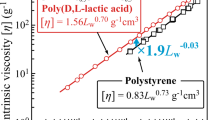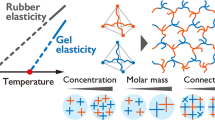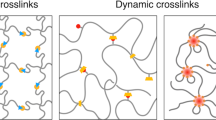Abstract
IN recent years, a great deal of attention has been devoted to the study of the effect of salts on the denaturation of biopolymers, both in the bulk state (for example, shrinkage of fibrous collagen) and in dilute solutions (for example, helix-coil transitions)1,2. Recent work in this laboratory3 has demonstrated that two main factors must be considered in describing the effects of both salt type and salt concentration on the shrinkage of collagen at neutral pH (when polyelectrolyte effects are absent). These are: the diluent and the specific effect. The former effect is predominant for salting-out agents, such as potassium chloride and magnesium sulphate, whereas the latter occurs with salting-in agents, such as potassium thiocyanate and lithium bromide. The diluent effect is satisfactorily described by the conventional melting point depression theory developed for binary polymer-diluent systems  where Tm is the melting temperature of the polymer in the presence of the diluent, Tm° the melting temperature of the undiluted polymer, ΔHu is the heat of fusion per mole of repeating unit, Vu the molar volume of the repeating unit, V1 the molar volume of the diluent, ζ1 the volume fraction of diluent, and χ1 represents a polymer–diluent interaction parameter which can be interpreted3 in terms of conventional salting-out theories4.
where Tm is the melting temperature of the polymer in the presence of the diluent, Tm° the melting temperature of the undiluted polymer, ΔHu is the heat of fusion per mole of repeating unit, Vu the molar volume of the repeating unit, V1 the molar volume of the diluent, ζ1 the volume fraction of diluent, and χ1 represents a polymer–diluent interaction parameter which can be interpreted3 in terms of conventional salting-out theories4.
This is a preview of subscription content, access via your institution
Access options
Subscribe to this journal
Receive 51 print issues and online access
$199.00 per year
only $3.90 per issue
Buy this article
- Purchase on Springer Link
- Instant access to full article PDF
Prices may be subject to local taxes which are calculated during checkout
Similar content being viewed by others
References
Schellmann, J. A., C. R. Trav. Lab. Carlsberg Ser. Chim., 29, 230 (1955). Flory, P. J., J. Cell. Comp. Physiol., 49 (Suppl. 1) (1957). Mandelkern, L., Crystallization of Polymers (McGraw-Hill, New York, 1964). Robinson, D. R., and Jencks, P., J. Amer. Chem. Soc., 87, 2462 (1965).
von Hippel, P. H., and Wong, K. Y., J. Biol. Chem., 240, 3909 (1965). Hamaguchi, K., and Geiduschek, E. P., J. Amer. Chem. Soc., 84, 1329 (1962).
Puett, D., Rajagh, L. V., and Ciferri, A., (to be published). Ciferri, A., Rajagh, L. V., and Puett, D., Biopolymers, 3, 46 (1965).
Long, F. A., and McDevitt, W. F., Chem. Rev., 51, 119 (1952).
Hildebrand, J. H., and Scott, R. L., The Solubility of Nonelectrolytes, (Dover Publications, 1964).
Docking, A. R., and Heyman, E., J. Phys. Chem., 43, 513 (1939).
Puett, D., Ciferri, A., and Rajagh, L. V., Biopolymers, 3, 439 (1965).
Orofino, T. A., Ciferri, A., and Hermans, J. J. (in preparation).
Author information
Authors and Affiliations
Rights and permissions
About this article
Cite this article
PUETT, D., GARMON, R. & CIFERRI, A. Role of Neutral Salts on the Denaturation Temperature of Biopolymers. Nature 211, 1294–1295 (1966). https://doi.org/10.1038/2111294a0
Issue Date:
DOI: https://doi.org/10.1038/2111294a0
Comments
By submitting a comment you agree to abide by our Terms and Community Guidelines. If you find something abusive or that does not comply with our terms or guidelines please flag it as inappropriate.



